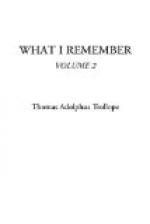The frequent occasions on which subsequently I saw Ristori produced an impression on me very much the reverse. I remember thinking Ristori’s “Mirra” too good, so terribly true as to be almost too painful for the theatre. I thought Rachel’s “Marie Stuart” upon the whole her finest performance, though “Adrienne” ran it hard.
Persiani, I note, supported by Lablache and Rubini, had a most triumphant reception in Inez de Castro, while Albertazzi was very coldly received in Blanche de Castille. Grisi in Norma was “superb.” “Persiani and P. Garcia sang a duet from Tancredi; it was divine! I think I like Garcia’s voice better than any of them. Nor could I think her ugly, as it is the fashion to call her, though it must be admitted that her mouth and teeth are alarming.”
Then there were brilliant receptions at the English Embassy (Lord Granville) and at the Austrian Embassy (Comte d’Appony). My diary remarks that stars and gold lace and ribbons of all the Orders in Christendom were more abundant at the latter, but female beauty at the former. I remember much admiring that of Lady Honoria Cadogan, and that of a very remarkably lovely Visconti girl, a younger sister of the Princess Belgiojoso. But despite this perfect beauty, my diary notes, that it was “curious to observe the unmistakable superiority as a human being of the young English patrician.” I remember that the “sit-down” suppers at the Austrian Embassy—a separate little table for every two, three, or four guests—were remarked on as a novelty (and applauded) by the Parisians.
Then at Miss Clarke’s (afterwards Madame Mohl) I find Fauriel, “the first Provencal scholar in Europe,” delightful, and am disgusted with Merimee, because he manifested self-sufficiency, as it seemed to my youthful criticism, by pooh-poohing the probability of the temple at Lanleff in Brittany having been aught else than a church of the Templars.
Then Arago reads an Eloge on “old Ampere,” of which I only remark that it lasted two hours and a half. Then there was a dinner at Dr. Gilchrist’s whose widow our old friend Pepe, who for many years had always called her “Madame Ghee-cree,” subsequently married. My notes, written the same evening, remind me that “I did not much like the radical old Doctor (his wife was an old acquaintance, but I had never seen him before); he is eighty, and ought to know better. Old Nymzevitch (I am not sure of the spelling), the ex-Chancellor of Poland, dined with us. He is eighty-four. When he said that he had conversed with the Duc de Richelieu, I started as if he had announced himself as the Wandering Jew. But, in fact, he had had, when a young man, an interview with the Duc, then ninety. He was, Nymzevitch told me, dreadfully emaciated, but dressed very splendidly in a purple coat all bedizened with silver lace. He received me, said the old ex-Chancellor, with much affable dignity."’
Then comes a breakfast with Pepe, at which I met the President Thibeaudeau, “a grey old man who makes a point of saying rude, coarse, and disagreeable things, which his friends call dry humour. He found fault with everything at the breakfast table.”




